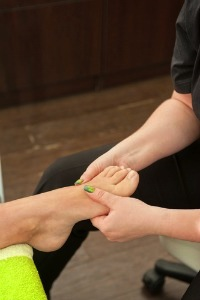
If you’ve ever experienced pain in the ball of your foot that feels like you’re walking on a marble or stone, you probably have a neuroma. A neuroma is simply an inflamed nerve in the ball of your foot, but boy, can it be painful. Neuromas are most commonly found between the long bones (metatarsals) behind the toes usually between the second and third toes or the third and fourth toes. Other signs of a neuroma include swelling in the same area, numbness or tingling in the ball of the foot, or pain when you place weight on the ball of the foot.
While a neuroma is technically a nerve tumor, it’s not as frightening as it sounds. They are benign tumors, and other than the pain they cause, there is nothing to worry about from a health perspective. They are really more of an annoyance than anything else. They may keep you from spending time on your feet or wearing high heeled shoes that place extra pressure on the ball of the foot. Consequently, women are more likely to develop neuromas. Let’s take a look at the causes and treatment options for neuromas.
What Causes Neuromas?
A neuroma may be caused by a number of things, but the most common factors include poor shoe choices or improperly fitting shoes, high heels (the higher the heel, the greater the risk for neuroma), injury, and anatomical or biomechanical deformities of the foot. Your profession can also contribute to the condition. Jobs that involve repeated stress on the ball of the foot (standing or walking most of the day) also increase the risk of developing a neuroma or can make an existing neuroma worse.
Treating Neuromas
If you suspect you have a neuroma, the first step you should take is to see your podiatrist for an evaluation. Without proper diagnosis and treatment, symptoms can often get worse. The podiatrists here at Kansas City Foot Specialists will have an in-depth discussion with you about your symptoms, footwear, health history, and habits. We will also perform a physical examination of your feet. Even if the symptoms only occur in one foot, both of your feet will be evaluated. We may also take x-rays of your feet.
Once you have a confirmed diagnosis of a neuroma, we will offer you a mix of at-home and in-office therapies. Our treatment for neuromas typically begins conservatively. Although your treatment plan will be developed with your individual needs in mind, a typical course of treatment follows a progression from non-invasive, conservative measures to more invasive, aggressive options.
Typical Treatment Plans Include:
Padding: You may be instructed to use small pads or cushions on the ball of the foot to relieve the pressure that causes the pain and symptoms of the neuroma.
Shoes: Adjusting the way you lace your shoes, switching to a lower heel, or wearing shoes that offer more room around the toes might help relieve symptoms. Shoes with shock-absorbing properties or extra padding may also help.
Medication: Depending on the severity of your symptoms, we may recommend anti-inflammatory medications, cortisone injections, or both.
Orthotics: Orthotics and shoe inserts can be used to treat many other foot-related complaints, and may also be used to reduce neuroma symptoms.
Surgery: If conservative interventions have failed to relieve your neuroma symptoms, or your symptoms have worsened, surgery may become an option. Surgery for neuromas typically involves removing inflamed or enlarged nerves that are causing symptoms and is often performed as an outpatient procedure.
To learn more about neuromas, or to have your feet evaluated, please contact Kansas City Foot Specialists today or call us at (913) 325-2958.




